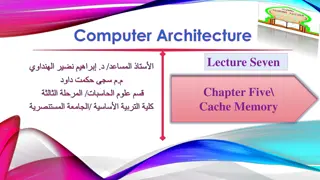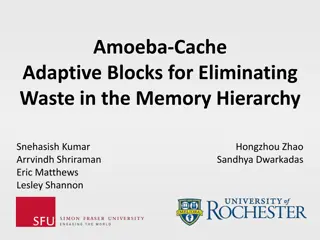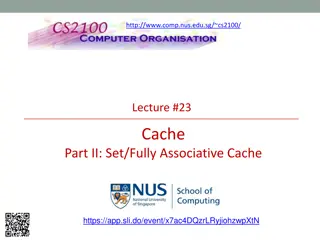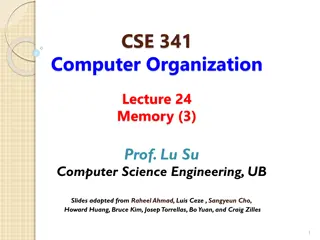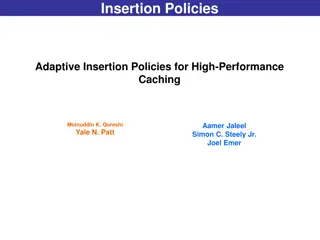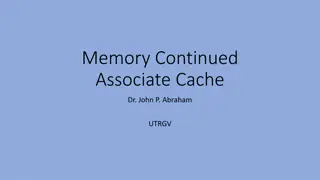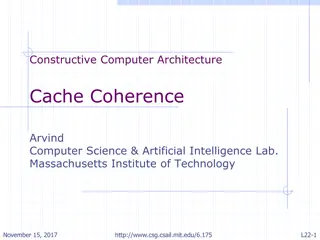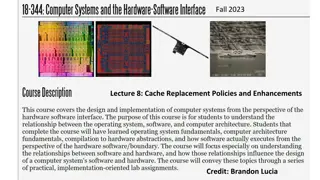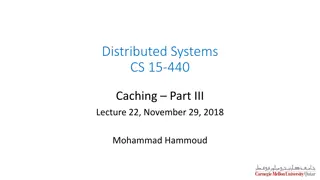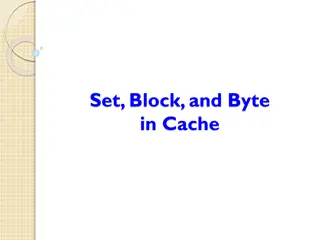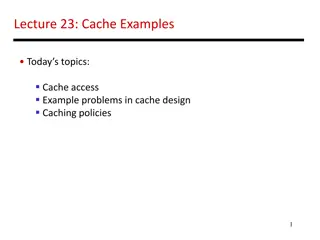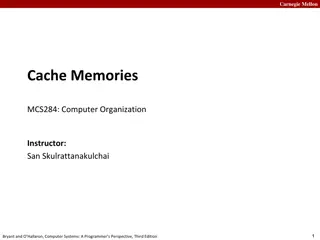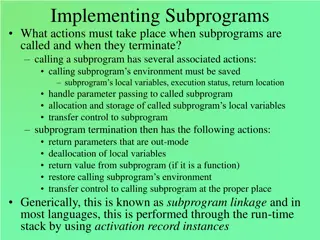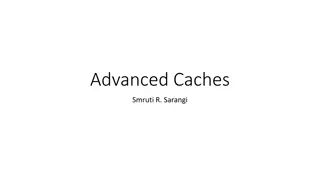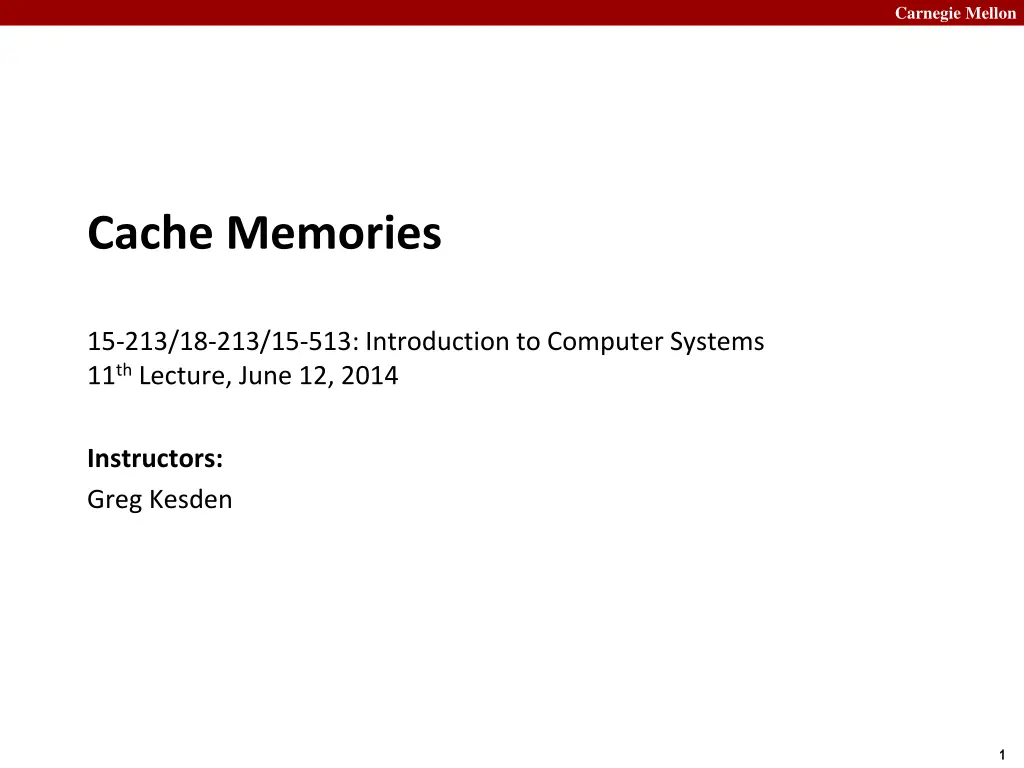
Understanding Cache Memories at Carnegie Mellon University
Explore the world of cache memories and their impact on computer systems through a series of lectures at Carnegie Mellon University. Topics include cache memory organization, performance impacts, types of caches, and CPU cache memories.
Download Presentation

Please find below an Image/Link to download the presentation.
The content on the website is provided AS IS for your information and personal use only. It may not be sold, licensed, or shared on other websites without obtaining consent from the author. If you encounter any issues during the download, it is possible that the publisher has removed the file from their server.
You are allowed to download the files provided on this website for personal or commercial use, subject to the condition that they are used lawfully. All files are the property of their respective owners.
The content on the website is provided AS IS for your information and personal use only. It may not be sold, licensed, or shared on other websites without obtaining consent from the author.
E N D
Presentation Transcript
Carnegie Mellon Cache Memories 15-213/18-213/15-513: Introduction to Computer Systems 11thLecture, June 12, 2014 Instructors: Greg Kesden 1
Carnegie Mellon Today Cache memory organization and operation Performance impact of caches The memory mountain Rearranging loops to improve spatial locality Using blocking to improve temporal locality 2
Carnegie Mellon General Cache Concept (Reminder) Smaller, faster, more expensive memory caches a subset of the blocks Cache 8 4 9 14 10 3 Data is copied in block-sized transfer units 4 10 Larger, slower, cheaper memory viewed as partitioned into blocks Memory 0 1 2 3 4 4 5 6 7 8 9 10 10 11 12 13 14 15 3
Carnegie Mellon Many types of caches Examples Hardware: L1 and L2 CPU caches, TLBs, Software: virtual memory, FS buffers, web browser caches, Many common design issues each cached item has a tag (an ID) plus contents need a mechanism to efficiently determine whether given item is cached combinations of indices and constraints on valid locations on a miss, usually need to pick something to replace with the new item called a replacement policy on writes, need to either propagate change or mark item as dirty write-through vs. write-back Different solutions for different caches Lets talk about CPU caches as a concrete example 4
Carnegie Mellon CPU Cache Memories CPU Cache memories are small, fast SRAM-based memories managed automatically in hardware Hold frequently accessed blocks of main memory CPU looks first for data in caches (e.g., L1, L2, and L3), then in main memory Typical system structure: CPU chip Register file Cache memories ALU System bus Memory bus Main memory I/O Bus interface bridge 5
Carnegie Mellon General Cache Organization (S, E, B) E = 2e lines per set set line S = 2s sets Cache size: C = S x E x B data bytes B-1 tag 0 1 2 v valid bit B = 2b bytes per cache block (the data) 6
Carnegie Mellon Locate set Check if any line in set has matching tag Yes + line valid: hit Locate data starting at offset Cache Read E = 2e lines per set Address of word: t bits s bits b bits S = 2s sets set index block offset tag data begins at this offset tag B-1 v 0 1 2 valid bit B = 2b bytes per cache block (the data) 7
Carnegie Mellon Example: Direct Mapped Cache (E = 1) Direct mapped: One line per set Assume: cache block size 8 bytes Address of int: v tag 0 1 2 3 4 5 6 7 t bits 0 01 100 v tag 0 1 2 3 4 5 6 7 find set S = 2s sets v tag 0 1 2 3 4 5 6 7 tag v 0 1 2 3 4 5 6 7 8
Carnegie Mellon Example: Direct Mapped Cache (E = 1) Direct mapped: One line per set Assume: cache block size 8 bytes Address of int: valid? + match: assume yes = hit t bits 0 01 100 v tag tag 0 1 2 3 4 5 6 7 block offset 9
Carnegie Mellon Example: Direct Mapped Cache (E = 1) Direct mapped: One line per set Assume: cache block size 8 bytes Address of int: valid? + match: assume yes = hit t bits 0 01 100 v tag 0 1 2 3 4 5 6 7 block offset int (4 Bytes) is here If tag doesn t match: old line is evicted and replaced 10
Carnegie Mellon Direct-Mapped Cache Simulation t=1 s=2 xx b=1 x M=16 bytes (4-bit addresses), B=2 bytes/block, S=4 sets, E=1 Blocks/set x Address trace (reads, one byte per read): 0 [00002], 1 [00012], 7 [01112], 8 [10002], 0 [00002] miss hit miss miss miss v Tag Block M[0-1] M[8-9] M[0-1] 0 1 1 1 ? 0 1 0 ? Set 0 Set 1 Set 2 Set 3 1 0 M[6-7] 11
Carnegie Mellon E-way Set Associative Cache (Here: E = 2) E = 2: Two lines per set Assume: cache block size 8 bytes Address of short int: t bits 0 01 100 v tag 0 1 2 3 4 5 6 7 v tag 0 1 2 3 4 5 6 7 find set v tag 0 1 2 3 4 5 6 7 v tag 0 1 2 3 4 5 6 7 v tag 0 1 2 3 4 5 6 7 v tag 0 1 2 3 4 5 6 7 v tag 0 1 2 3 4 5 6 7 v tag 0 1 2 3 4 5 6 7 12
Carnegie Mellon E-way Set Associative Cache (Here: E = 2) E = 2: Two lines per set Assume: cache block size 8 bytes Address of short int: t bits 0 01 100 compare both valid? + match: yes = hit v tag tag 0 1 2 3 4 5 6 7 v tag 0 1 2 3 4 5 6 7 block offset 13
Carnegie Mellon E-way Set Associative Cache (Here: E = 2) E = 2: Two lines per set Assume: cache block size 8 bytes Address of short int: t bits 0 01 100 compare both valid? + match: yes = hit v tag 0 1 2 3 4 5 6 7 v tag 0 1 2 3 4 5 6 7 block offset short int (2 Bytes) is here No match: One line in set is selected for eviction and replacement Replacement policies: random, least recently used (LRU), 14
Carnegie Mellon 2-Way Set Associative Cache Simulation t=2 s=1 x b=1 x M=16 byte addresses, B=2 bytes/block, S=2 sets, E=2 blocks/set xx Address trace (reads, one byte per read): 0 [00002], 1 [00012], 7 [01112], 8 [10002], 0 [00002] miss hit miss miss hit v Tag Block 0 0 1 ? 00 10 ? M[0-1] M[8-9] 1 Set 0 0 0 1 01 M[6-7] Set 1 15
Carnegie Mellon What about writes? Multiple copies of data exist: L1, L2, Main Memory, Disk What to do on a write-hit? Write-through (write immediately to memory) Write-back (defer write to memory until replacement of line) Need a dirty bit (line different from memory or not) What to do on a write-miss? Write-allocate (load into cache, update line in cache) Good if more writes to the location follow No-write-allocate (writes straight to memory, does not load into cache) Typical Write-through + No-write-allocate Write-back + Write-allocate 16
Carnegie Mellon Intel Core i7 Cache Hierarchy Processor package Core 0 Core 3 L1 i-cache and d-cache: 32 KB, 8-way, Access: 4 cycles Regs Regs L1 L1 L1 L1 L2 unified cache: 256 KB, 8-way, Access: 11 cycles d-cache i-cache d-cache i-cache L2 unified cache L2 unified cache L3 unified cache: 8 MB, 16-way, Access: 30-40 cycles L3 unified cache (shared by all cores) Block size: 64 bytes for all caches. Main memory 17
Carnegie Mellon Cache Performance Metrics Miss Rate Fraction of memory references not found in cache (misses / accesses) = 1 hit rate Typical numbers (in percentages): 3-10% for L1 can be quite small (e.g., < 1%) for L2, depending on size, etc. Hit Time Time to deliver a line in the cache to the processor includes time to determine whether the line is in the cache Typical numbers: 1-2 clock cycle for L1 5-20 clock cycles for L2 Miss Penalty Additional time required because of a miss typically 50-200 cycles for main memory (Trend: increasing!) 18
Carnegie Mellon Lets think about those numbers Huge difference between a hit and a miss Could be 100x, if just L1 and main memory Would you believe 99% hits is twice as good as 97%? Consider: cache hit time of 1 cycle miss penalty of 100 cycles Average access time: 97% hits: 1 cycle + 0.03 * 100 cycles = 4 cycles 99% hits: 1 cycle + 0.01 * 100 cycles = 2 cycles This is why miss rate is used instead of hit rate 19
Carnegie Mellon Writing Cache Friendly Code Make the common case go fast Focus on the inner loops of the core functions Minimize the misses in the inner loops Repeated references to variables are good (temporal locality) Stride-1 reference patterns are good (spatial locality) Key idea: Our qualitative notion of locality is quantified through our understanding of cache memories 20
Carnegie Mellon Back to Observations Programmer can optimize for cache performance How data structures are organized How data are accessed (examples follow) Nested loop structure Blocking is a general technique All systems favor cache friendly code Getting absolute optimum performance is very platform specific Cache sizes, line sizes, associativities, etc. Can get most of the advantage with generic code Keep working set reasonably small (temporal locality) Use small strides (spatial locality) 21
Carnegie Mellon Today Cache organization and operation Performance impact of caches The memory mountain Rearranging loops to improve spatial locality Using blocking to improve temporal locality 22
Carnegie Mellon The Memory Mountain Read throughput (read bandwidth) Number of bytes read from memory per second (MB/s) Memory mountain: Measured read throughput as a function of spatial and temporal locality. Compact way to characterize memory system performance. 23
Carnegie Mellon Memory Mountain Test Function /* The test function */ void test(int elems, int stride) { int i, result = 0; volatile int sink; for (i = 0; i < elems; i += stride) result += data[i]; sink = result; /* So compiler doesn't optimize away the loop */ } /* Run test(elems, stride) and return read throughput (MB/s) */ double run(int size, int stride, double Mhz) { double cycles; int elems = size / sizeof(int); test(elems, stride); /* warm up the cache */ cycles = fcyc2(test, elems, stride, 0); /* call test(elems,stride) */ return (size / stride) / (cycles / Mhz); /* convert cycles to MB/s */ } 24
Carnegie Mellon A Ridge of Temporal Locality (s=16) 27
Carnegie Mellon A Slope of Spatial Locality (size=4MB) 29
Carnegie Mellon Today Cache organization and operation Performance impact of caches The memory mountain Rearranging loops to improve spatial locality Using blocking to improve temporal locality 31
Carnegie Mellon Miss Rate Analysis for Matrix Multiply Assume: Line size = 32B (big enough for four 64-bit words) Matrix dimension (N) is very large Approximate 1/N as 0.0 Cache is not even big enough to hold multiple rows Analysis Method: Look at access pattern of inner loop j j k = x i i k C A B 32
Carnegie Mellon Matrix Multiplication Example Variable sum held in register Description: Multiply N x N matrices O(N3) total operations N reads per source element N values summed per destination /* ijk */ for (i=0; i<n; i++) { for (j=0; j<n; j++) { sum = 0.0; for (k=0; k<n; k++) sum += a[i][k] * b[k][j]; c[i][j] = sum; } } but may be able to hold in register 33
Carnegie Mellon Layout of C Arrays in Memory (review) C arrays allocated in row-major order each row in contiguous memory locations Stepping through columns in one row: for (i = 0; i < N; i++) sum += a[0][i]; accesses successive elements if block size (B) > 4 bytes, exploit spatial locality miss rate = 4 bytes / B Stepping through rows in one column: for (i = 0; i < n; i++) sum += a[i][0]; accesses distant elements no spatial locality! miss rate = 1 (i.e. 100%) 34
Carnegie Mellon Matrix Multiplication (ijk) /* ijk */ for (i=0; i<n; i++) { for (j=0; j<n; j++) { sum = 0.0; for (k=0; k<n; k++) sum += a[i][k] * b[k][j]; c[i][j] = sum; } } Inner loop: (*,j) (i,j) (i,*) A B C Row-wise Column- wise Fixed Misses per inner loop iteration: A 0.25 B 1.0 C 0.0 35
Carnegie Mellon Matrix Multiplication (jik) /* jik */ for (j=0; j<n; j++) { for (i=0; i<n; i++) { sum = 0.0; for (k=0; k<n; k++) sum += a[i][k] * b[k][j]; c[i][j] = sum } } Inner loop: (*,j) (i,j) (i,*) A B C Row-wise Column- Fixed wise Misses per inner loop iteration: A 0.25 B 1.0 C 0.0 36
Carnegie Mellon Matrix Multiplication (kij) /* kij */ for (k=0; k<n; k++) { for (i=0; i<n; i++) { r = a[i][k]; for (j=0; j<n; j++) c[i][j] += r * b[k][j]; } } Inner loop: (i,k) (k,*) (i,*) A B C Row-wise Row-wise Fixed Misses per inner loop iteration: A 0.0 B C 0.25 0.25 37
Carnegie Mellon Matrix Multiplication (ikj) /* ikj */ for (i=0; i<n; i++) { for (k=0; k<n; k++) { r = a[i][k]; for (j=0; j<n; j++) c[i][j] += r * b[k][j]; } } Inner loop: (i,k) (k,*) (i,*) A B C Row-wise Row-wise Fixed Misses per inner loop iteration: A 0.0 B C 0.25 0.25 38
Carnegie Mellon Matrix Multiplication (jki) Inner loop: /* jki */ for (j=0; j<n; j++) { for (k=0; k<n; k++) { r = b[k][j]; for (i=0; i<n; i++) c[i][j] += a[i][k] * r; } } (*,k) (*,j) (k,j) A B C Column- wise Fixed Column- wise Misses per inner loop iteration: A 1.0 B 0.0 C 1.0 39
Carnegie Mellon Matrix Multiplication (kji) /* kji */ for (k=0; k<n; k++) { for (j=0; j<n; j++) { r = b[k][j]; for (i=0; i<n; i++) c[i][j] += a[i][k] * r; } } Inner loop: (*,k) (*,j) (k,j) A B C Column- wise Fixed Column- wise Misses per inner loop iteration: A 1.0 B 0.0 C 1.0 40
Carnegie Mellon Summary of Matrix Multiplication for (i=0; i<n; i++) { for (j=0; j<n; j++) { sum = 0.0; for (k=0; k<n; k++) sum += a[i][k] * b[k][j]; c[i][j] = sum; } } ijk (& jik): 2 loads, 0 stores misses/iter = 1.25 for (k=0; k<n; k++) { for (i=0; i<n; i++) { r = a[i][k]; for (j=0; j<n; j++) c[i][j] += r * b[k][j]; } } kij (& ikj): 2 loads, 1 store misses/iter = 0.5 for (j=0; j<n; j++) { for (k=0; k<n; k++) { r = b[k][j]; for (i=0; i<n; i++) c[i][j] += a[i][k] * r; } } jki (& kji): 2 loads, 1 store misses/iter = 2.0 41
Carnegie Mellon Core i7 Matrix Multiply Performance 60 jki / kji 50 Cycles per inner loop iteration 40 jki kji ijk jik kij ikj 30 ijk / jik 20 10 kij / ikj 0 50 100 150 200 250 300 350 400 450 500 550 600 650 700 750 Array size (n) 42
Carnegie Mellon Core i7 Matrix Multiply Performance 60 jki / kji 50 Cycles per inner loop iteration Pay attention to spatial locality! Miss rate more important than # of mem refs Pay particular attention to inner loops (Amdahl s law) Its not that hard to do the analysis 40 jki kji ijk jik kij ikj 30 ijk / jik 20 10 kij / ikj 0 50 100 150 200 250 300 350 400 450 500 550 600 650 700 750 Array size (n) 43
Carnegie Mellon Today Cache organization and operation Performance impact of caches The memory mountain Rearranging loops to improve spatial locality Using blocking to improve temporal locality 44
Carnegie Mellon Example: Matrix Multiplication c = (double *) calloc(sizeof(double), n*n); /* Multiply n x n matrices a and b */ void mmm(double *a, double *b, double *c, int n) { int i, j, k; for (i = 0; i < n; i++) for (j = 0; j < n; j++) for (k = 0; k < n; k++) c[i*n+j] += a[i*n + k]*b[k*n + j]; } j c a b = * i 45
Carnegie Mellon Cache Miss Analysis Assume: Matrix elements are doubles Cache block = 8 doubles Cache size C << n (much smaller than n) n First iteration: n/8 + n = 9n/8 misses = * Afterwards in cache: (schematic) = * 8 wide 46
Carnegie Mellon Cache Miss Analysis Assume: Matrix elements are doubles Cache block = 8 doubles Cache size C << n (much smaller than n) n Second iteration: Again: n/8 + n = 9n/8 misses = * 8 wide Total misses: 9n/8 * n2 = (9/8) * n3 47
Carnegie Mellon Blocked Matrix Multiplication c = (double *) calloc(sizeof(double), n*n); /* Multiply n x n matrices a and b */ void mmm(double *a, double *b, double *c, int n) { int i, j, k; for (i = 0; i < n; i+=B) for (j = 0; j < n; j+=B) for (k = 0; k < n; k+=B) /* B x B mini matrix multiplications */ for (i1 = i; i1 < i+B; i++) for (j1 = j; j1 < j+B; j++) for (k1 = k; k1 < k+B; k++) } c[i1*n+j1] += a[i1*n + k1]*b[k1*n + j1]; j1 c a b c = + * i1 Block size B x B 48
Carnegie Mellon Cache Miss Analysis Assume: Cache block = 8 doubles Cache size C << n (much smaller than n) Three blocks fit into cache: 3B2 < C n/B blocks First (block) iteration: B2/8 misses for each block 2n/B * B2/8 = nB/4 (omitting matrix c) = * Block size B x B Afterwards in cache (schematic) = * 49
Carnegie Mellon Cache Miss Analysis Assume: Cache block = 8 doubles Cache size C << n (much smaller than n) Three blocks fit into cache: 3B2 < C n/B blocks Second (block) iteration: Same as first iteration 2n/B * B2/8 = nB/4 = * Total misses: nB/4 * (n/B)2 = n3/(4B) Block size B x B 50


